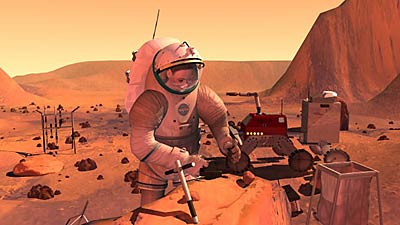Will Mars challenge the “prime directive”?by James C. McLane III
|
| Any adaptations that enable a living thing to survive for millennia in the special environment of a cave would render it ill equipped to contend with life on the surface. This same logic applies to Mars. |
It’s possible we’ve already encountered life from outer space. In 1998, scientists Neva Ciftcioglu and Olavi Kajander working in Finland discovered that a tiny, bizarre creature was living in the blood of many Swedes. The same strange microbe was even more common in cattle. This newly-found life form, dubbed a nanobacteria, has several characteristics that separate it from all known terrestrial organisms. It is extremely small (virus-sized), it reproduces very slowly, and it can be killed by antibiotics just like larger, conventional bacteria. Most peculiarly, it has, by far, the highest heat and radiation resistance of any known living thing.
These characteristics support the idea that this creature did not evolve to its current state inside humans. Indeed, it’s not even possible to say if this nanobacteria is beneficial, harmful, or just a neutral epiphyte in the human body. There is a fair chance such rugged life forms are travelers from outer space that originally arrived via a meteorite. Whatever they are, they don’t seem to be a threat to humanity.
Here on Earth, remnant colonies of exotic, highly specialized organisms are regularly discovered in remote and inhospitable places, like undersea thermal springs and in the dark isolation of caves. The Earth seems full of life in improbable places and we are just beginning to appreciate that fact. Speculation abounds about whether weird, undiscovered life forms might exist in places with highly unusual evolutionary pressures, like in the mysterious fresh water lakes that are trapped under the ice near the South Pole, or in oil and gas wells, or even in chemically-toxic geothermal springs.
Near Austin, Texas, a handful of tiny caves are the only home in the world to a rare creature. The Rhadine Persephone is a small red beetle that never ventures from the darkest regions of the cave. This insect is a descendent of ancient life, trapped by circumstance and specialized by evolution to live suspended in a silent, sunless, unchanging environment where time seems to stand still. The Rhadine Persephone can’t survive on the surface and creatures on the surface can’t survive for long in the cave.
It’s possible that these beetles and other strange cave life may themselves support colonies of microorganisms that are not found outside the cave. Should we be concerned that such unknown bacteria or fungi might be a threat to humans?
Outside Sydney, Australia, a cave contains clay that scientists think was deposited around 300 million years ago. What if living organic material washed in with the mud and continued to live down there, in extreme isolation, since the time of the dinosaurs? Should cave explorers worry about encountering a prehistoric germ that might harm human life?
| We shouldn’t worry about polluting the planet Mars with terrestrial microbes hitchhiking in on visiting astronauts. The likelihood of Earth-based organisms thriving on Mars is nil. |
No! Any adaptations that enable a living thing to survive for millennia in the special environment of a cave would render it ill equipped to contend with life on the surface. This same logic applies to Mars. Any life that exists there would be much too highly specialized to interact with humans or any Earth-evolved life.
A new lab to study returned Mars rocks might be useful to concentrate imaginative technical talent in one place. But, any sample isolation should only be the minimum required to support scientific study. The lab doesn’t have to protect the Earth from contamination by Martian bugs.
In like manner, we shouldn’t worry about polluting the planet Mars with terrestrial microbes hitchhiking in on visiting astronauts. The likelihood of Earth-based organisms thriving on Mars is nil. The so-called “Prime Directive” often mentioned in the science fiction show “Star Trek” commanded humans to avoid interfering with the natural development of primitive life on other planets. This advice would not be violated by a manned landing on Mars.
